|
Editor’s Note:
Author John Hawthorne saw an article on TI Life that related to a Float Plan. He had just posted one of his own and asked if we would like a link. I suggested it was important and asked to republish it in Thousand Islands Life: https://moboxmarine.com/blog/guide-creating-float-plan/
|
Few things are better than a day on the water, right? The sun, the wind in your face, the water lapping calmly against the boat. It’s peaceful. Relaxing. Calm. If you’re more of the adventurous type, maybe you’ll strap on some water skis and go flying around a lake. Or maybe you’re headed to deep water to catch a monster.
When you go out on the water, you probably tell your spouse, or friends, where you’re headed and approximately what time you’ll be back. Or maybe you leave a note attached to the refrigerator that only contains the words, “Be back around 7”. Or, maybe you don’t tell anyone where you’re going. You’re an adult after all! You can do what you want.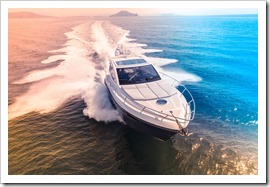
But you really should be more detailed than that.
In this post, we’re going to try to convince you that you should actually create a float plan before
you hit the water.
What is a float plan and why do you need it?
A float plan is a detailed list of information regarding your trip. It contains the who, what, where, and why of your outing. Think of it as an inventory of the entire trip.
You need it because every year the Coast Guard receives calls about people who haven’t returned from a boating trip. Unfortunately, unless the missing person left behind a detailed float plan, it can be hard to know where they were headed, who was with them, and when they were expected to return.
A float plan is a safety measure. Think of it like car insurance. You hope you never need it, but you should have it on hand anyway. If you don’t have car insurance, you can go to jail. If you don’t have a float plan, you can get lost at sea, never to be seen again and forced to live on a deserted island for the rest of your life.
I can hear all you seasoned water vets yelling, “We don’t need no stinking float plans!”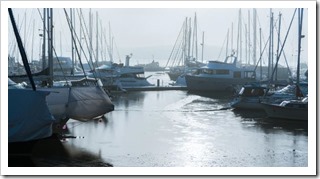
Well, the U.S. Coast Guard Auxiliary puts it like this:
"The answer is simple... there are just too many facts that need to be accurately remembered and ultimately conveyed in an emergency situation. Without a float plan, you are counting on someone else, a friend, neighbor, or family member, to remember detailed information that rescue personnel need in order to find you. Information that can make a difference in the outcome."
Just hear us out on this one. Here’s what you need to know to create a good float plan.
STEP #1: Pick Some Responsible People as Your Float Plan Guardians
You should have at least two people who will have your float plan. These should be responsible adults. Your buddy,Tito, who passes out at the bar every night probably isn’t your best choice. You need to pick someone who will be able to contact the proper authorities if something goes amiss.
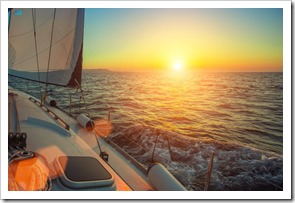
On the other hand, you probably don’t want to pick someone who is a notorious worrier, such as your grandmother. She’ll be on the phone if you’re more than 30 seconds late for your arrival.
Pick two responsible adults, either friends or family, who you know will be able to handle things properly, should the need arise.
STEP #2: Tell Your Guardians Your ETA
Your guardians should know the approximate time you’ll arrive at your destination. But (and this is key), they should also know how long to wait before contacting authorities, if you fail to check in.
This means you’ll need to calculate an approximate buffer window around your arrival time that can accommodate the various conditions you’ll encounter. To calculate this buffer time, you’ll need to consider conditions like:
- The weather
- The winds
- The current
- Boat speed
- Any known issues with your boat that could slow you down
- Possible stops you could be making ie. to swim, (editor’s note: or to report to border control authorities.)
You need to consider how long things “could” take for your trip. You may think you’re going to arrive at a particular time, but you should always give yourself an appropriate buffer. The longer your trip, the bigger your buffer will need to be to handle all circumstances that could arrive.
Your float plan guardians should only alert the authorities if you fail to check in after the buffer time.
STEP #3: Provide Your Plan Guardians with Emergency Contact Info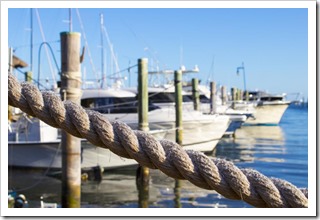
If things go South, you don’t want your float plan guardians scrambling to find the emergency number of the Coast Guard, or the marine patrol where you’ll be boating. You want them to have that number on hand quickly.
Make sure to include that information in your float plan in big, bold print
STEP #4: Include Details About Your Boat
If your guardians need to contact authorities, they’ll need to provide details about your boat. You should include all the necessary details in your float plan:
- Boat name
- Hailing port
- Registration #
- Year, Make, & Model
- Length
- Type
- Draft
- Hull material
- Hull and trim colors
- Prominent features
- The primary propulsion type
- The auxiliary propulsion type
You’ll also need to provide the details about the communications system you have on board, including:
- Radio call sign/number
- DSC MMSI number
- Radio 1 type and the channel to be monitored
- Radio 2 type and the channel to be monitored
- Cell/Satellite info
- Email
STEP #5: Specify Visual Distress Signals
If you get in trouble, you’ll be providing visual distress signals for those who are searching for you. Your float plan guardians should be able to tell the authorities what those distress signals are. For example: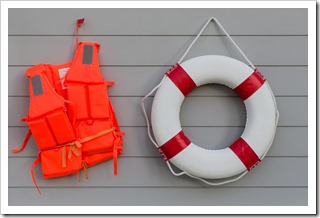
- An electric distress light
- A flag
- Aerial flares
- Handheld flares
- Signal mirror
- Smoke
- Bell
- Horn
- Whistle
- You dancing on the deck while holding flares and blaring the chorus to “In The Air Tonight” by Phil Collins.
If the authorities know what to look or listen for, they’ll be able to find you more quickly.
STEP #6: Specify the Safety Gear Aboard the Boat
The authorities will probably want to know what sort of safety gear is aboard your boat. Include all these details on the float plan. List things like:
- The line length of your anchor
- Whether you have a dewatering device
- The number of exposure suits (if any)
- The number of fire extinguishers
- Whether you have flashlights and searchlights
- Whether you have a raft
- The amount of food you have aboard
This information will help authorities know the urgency of the situation. For example, if you are lost at sea and have no food, no water, and no raft, the Coast Guard knows they need to move quickly.
Seriously though, pack appropriate food and water. Don’t be stupid.
STEP #7: Fill-In Details for Everyone Aboard the Boat
Your float plan should include detailed information about everyone who will be on the boat, including you, your crew, and passengers. This information should include:
- Age
- Physical description (height, weight, hair, etc.)
- Medical information (existing conditions, allergies, etc.)
- Emergency contacts
- Favorite member of The Rolling Stones (just kidding)
This information will be absolutely essential, to rescue crews when they are searching for missing personnel.
STEP #8: Update Your Float Plan If Possible
If things change during your trip, update your float plan if possible. This may mean calling your float plan guardians or sending them an electronic communication if you have access to email.
You want to keep your guardians in the loop as much as possible to avoid needless worry. You also don’t want them unnecessarily calling the Coast Guard.
Additionally, failing to update your float plan could have disastrous consequences if you get into trouble and the authorities end up searching in the wrong location. Everyone should have the most accurate information possible at all times
STEP #9: Check-in At Your Final Destination
When you arrive at your final destination, be sure to close out your float plan. You want everyone to know that you arrived safely. Don’t be that person who arrives on location, has a blast, and totally forgets to check in at home.
Nobody likes that person.
Conclusion
Float plans aren’t complicated. They don’t take hours of time to create and you’ll really want to have one, if things get hairy.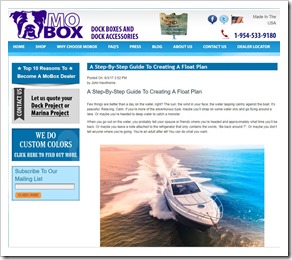
And, if you create a master copy, you can repeatedly use it on future trips, which will save you a lot of time. You’ll need to update much less information.
Even if you’re a seasoned sailor, consider this as a necessary safety precaution. Like life vests, or an emergency radio system. You hope you don’t have to use them, but it’s really good to have them on hand.
Now get out there and enjoy the water. And come back when you’re supposed to!
NOTE: The Coast Guard has a float plan which you can download and use yourself. Click here to access it.
By John Hawthorne
John Hawthorne writes a blog on the MoBox Webpage : https://moboxmarine.com/blog/. The company manufactures dock boxes and dock accessories. Made in the USA MoBox Marine says it “has a passion to produce quality products” for the marine industry. The Hawthrone blog has a long list of helpful hints for boaters and fishermen.
Photographs: Photographs included in this article appear in the original MoBox blog post.